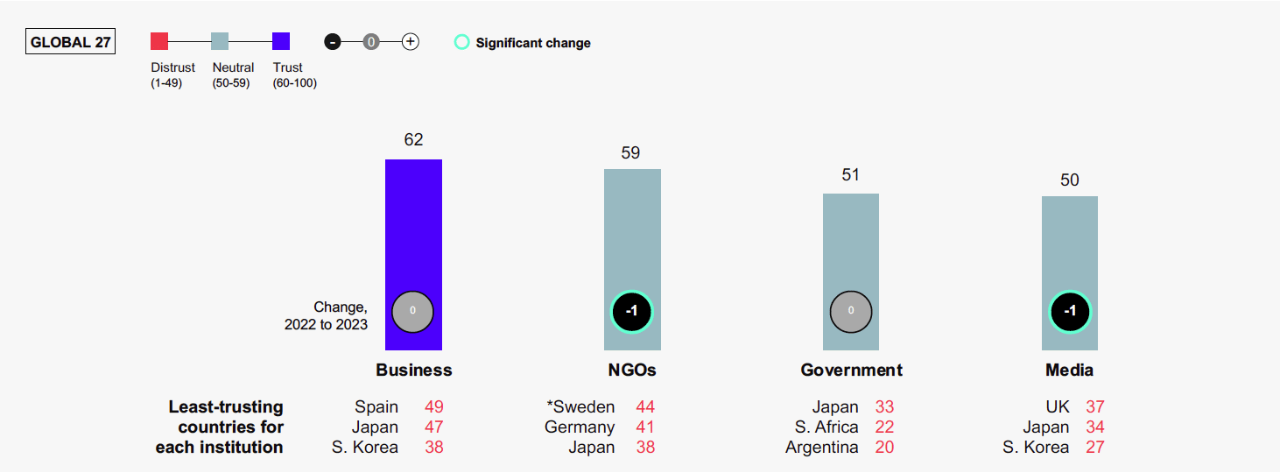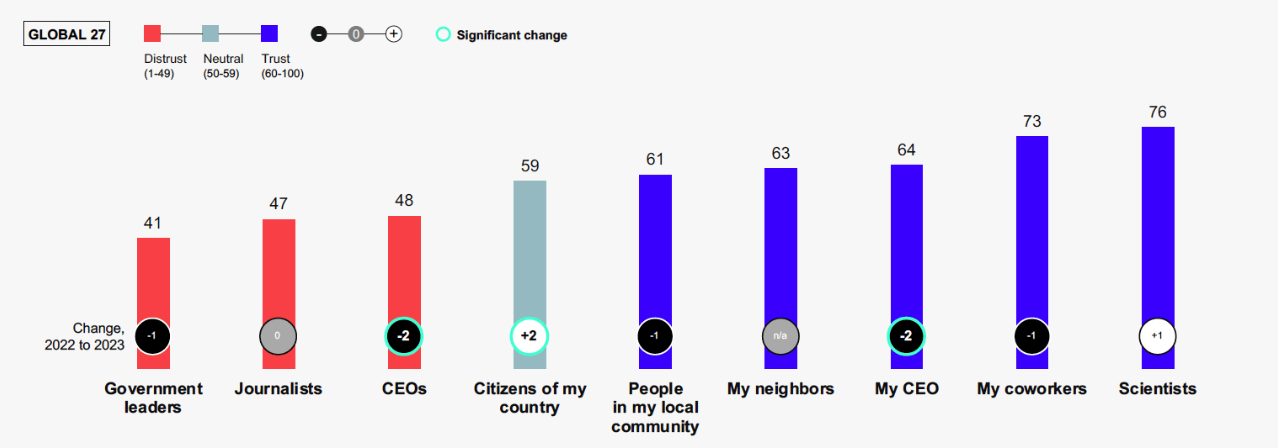It’s an ever-evolving concept.
Businesses are ranked higher than NGOs, Government, and the Media. More than a decade ago, Media held the highest ranking.
Politicians, Journalists, and CEOs are highest in distrust. Whereas “your CEO,” neighbors, coworkers and scientists hold the highest rankings.
Very few would help, live near, or work with someone who disagreed with their point of view:
30
Would help them if they were in need.20
Would be willing to live in the same neighborhood.20
Would be willing to have them as a coworker.Think about what these mean. The graphic above says we trust coworkers and neighbors.
BUT, if they don’t agree with us, we want little to do with them.
for us in IMC?
Today we realize there are more things in play.
Percentages represent aggregate totals for responses to “completely trust” and “somewhat trust.”
Percentages represent aggregate totals for responses to “completely trust” and “somewhat trust.”
of these findings in context
Here are some of the most repeated explanations to the following questions.
Why are branded (Owned) websites ranked so highly?
How can this be? Why would someone trust Brand X’s website? Because the only people who would respond to this question are people further down the AIDA funnel. These people are already at the “consideration” stage, and they’ve generally switched from peripheral to central processing.
They didn’t just accidentally end up on the website. They chose to go there. More than likely, people who have this feeling have decided that “they” are the ultimate arbiters of “trust” and more than capable of comparing what Brand X says versus Brand Y’s website.
Why are social media ads ranked so low?
Remember, this doesn’t just apply to ads, as most studies show only about 50% of people can tell the difference between an organic (Owned and Shared) post versus a Paid one.
Why are you on social media? To be entertained. To become slightly more informed. Branded posts are seen as disrupting that use. In fact, since you “curate” your own stream within the app’s algorithm, you didn’t ask for these, and they are seen as even more disruptive than ads in traditional media.
That doesn’t mean they aren’t effective, it just means too much of these may start to grate on people’s nerves.
Why are online video ads ranked so much lower than TV?
Yes, what this means is that if an ad for Brand X shows up on a digital stream, such as YouTube, they are often trusted about 1/2 of what they might be trusted in a more traditional media. Wow!?
Five well-versed explanations…
- A) The main explanation for this is that “commercial breaks” for ads are normally spaced 10-12 minutes apart. Sometimes you might get three interruptions within a 3-4 minute YouTube video. More frequent interruptions, means a feeling of frustration, which leads to lower trust.
- B) Similarly, we can often watch 10-12 minutes of content on more traditional TV (or videos) without an interruption. But don’t you often have to sit through at least one skippable ad before EVERY video you watch online? And these aren’t just confined to YouTube. Go to espn.com, or similar sites, and to watch any video highlight you have to sit through a non-skippable ad of 15 seconds or so before seeing your 15-30 second highlight! #Frustration #Interruptive
- C) Ads during streaming content on Hulu, Paramount+, Peacock, etc., are also less trusted than traditional TV formats. Why? Because we started watching streaming services, like Netflix, to avoid ads. And here they are!
- D) Lastly, the call-to-action on most online videos is pretty intense. This gives them a more “hard-sell” feel, whereas a higher percentage of ads on traditional TV are built for brand awareness (ToFU) and filled with puffery and light-hearted messages.
- E) Digital is a “noisy” environment. It’s hard to believe something when we are more distracted.
Why are branded (Owned) websites ranked so highly?
I’m not sure I believe this one as much as some of the surveys report. However, it is clear that Earned media doesn’t necessarily hold the same place of respect as it once did. Why? The two most common explanations are:
A) Fake news. The public fear of this has increased tremendously over the past 10 years. Maybe some of it is justified. But the place where people scream this the most are comments from short posts or updates on social media.
B) Earned media tends to be longer in format: either through text or video. With all the time we spend online in our peripheral mindset, engaging with longer form content can be frustrating.
A planner needs to be map out a journey with long and short content.
Yes, we should consider the normal “trust” factor of different platforms, but…
- A person who loves your brand will probably love you no matter what platform you use.
- A person who is just experiencing “first contact” with your brand will probably be more impacted by the sources of the media listed above.
- A strategist has to create a plan that includes some passive and some active content, and a combination of messages that are pushy and softer. This also means I want to use the right medium to reach the right audience, but they need to understand that the “trust factor” means some platforms will garner more “push back” from the targeted audience.


